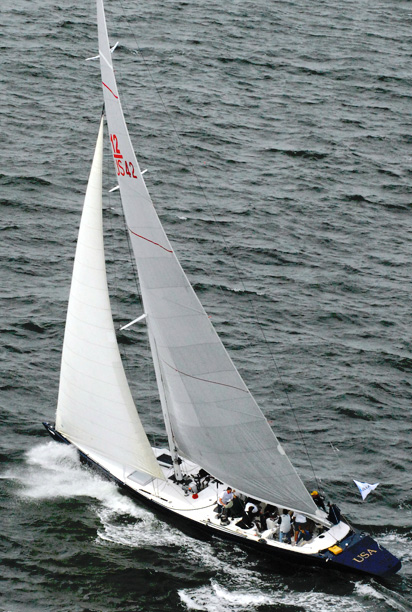 The 12m Class and the America’s Cup
The 12m Class and the America’s Cup
By Halsey C. Herreshoff
Credit: www.herreshoff.org
The 150-year history of the America’s Cup, the oldest and most distinguished prize in world sport, is summarized from the author’s vantage point of belonging to a family of boat designers and builders who contributed to the dominance of American yachts from the beginning into the 1980s. Particulars and performances of the most important designs are described from AMERICA to the current International America’s Cup Class.
Introduction
The America’s Cup is the Holy Grail of yacht racing. It is much more. This Cup, in competition for a period of 150 years, is the oldest and most distinguished trophy in all sport, outdating the World Cup, Davis Cup, Stanley Cup, Walker Cup, and all others of significance. Excepting the lavish excesses of big time modern professional sport, more talent, effort, and money have been devoted to the America’s Cup than for any other sport competitions. From the standpoint of naval architecture, America’s Cup intensity has inspired countless design breakthroughs, fallout from which benefit all yachts today to an extent generally unrealized by those who sail. Here, a highly focused pursuit of excellence has provided quality, boldness, and dedication to be the best. The most elegant hull lines, most efficient construction, best sails, and most skillful sailing techniques have evolved from America’s Cup competition.
For 132 years (1851 to 1983), the United States enjoyed the longest winning streak in all sport. There were close calls but always the U.S. won the series and most of the individual races. Through that time, American yachts were generally, though not always, the fastest; thus, it may be fairly stated that victories followed very much from technical prowess.
As with any ship design, a sailing yacht embodies many necessary elements, which must dovetail to accomplish its mission. What is nice about America’s Cup design is that the only mission is speed, maneuverability and reliability to best a single match race rival around a closed course. Size, weight, wetted surface, hull form, light but strong construction, efficient rigs with good sails, sea kindliness and maneuverability are necessary. In general the successful boats embody acceptable or superior selections in the above categories. Bold innovation has been rewarded, but nearly always, extremes have failed. In a series of yacht races encompassing generally a variety of wind and sea conditions, an overall good boat wins.
It is appropriate to divide America’s Cup history into seven logical chronological divisions. The outstanding or most interesting yacht of each period will be addressed herewith. Listed below are the America’s Cup competitions by era with the names of the winning and defeated yachts respectively. In each case the focus yacht is in boldface type.
The l2-Metre era: 1958-1987
Following World War II, the conventional wisdom on both sides of the Atlantic was that the America’s Cup was done. The world was rebuilding and there seemed little prospect of funding further J boats given their assumed greatly accelerated cost. The Cup itself remained the pride of the New York Yacht Club, continually on display in the trophy room of the 44th Street Club House. Most of us expected it to just remain there for a long time, perhaps never to be raced for again.
Enter Commodores Henry Sears and Henry Morgan of the New York Yacht Club. By petitioning the Supreme Court of the State of New York, they modified the Deed of Gift to allow smaller yachts without the previous demand that challengers must cross the ocean on their own bottoms. It was agreed to compete in the International 12-Metre Class, which had provided excellent racing for several years before the war. Designed to the rather tight specifications of the International Rule, these boats did not really fit the grand traditions of the Cup but nevertheless provided nearly three decades of some of the finest match racing ever.
1958-1987: The 12-Metres
1958 COLUMBIA vs. SCEPTRE
1962 WEATHERLY vs. GRETEL
1964 CONSTELLATION vs. SOVEREIGN
1967 INTREPID vs. DAME PATTIE
1970 INTREPID vs. GRETEL II
1974 COURAGEOUS vs. SOUTHERN CROSS
1977 COURAGEOUS vs. AUSTRALIA
1980 FREEDOM vs. AUSTRALIA
1983 AUSTRALIA II vs. LIBERTY
1987 STARS & STRIPES vs. KOOKABURRA III
I can write more knowledgeably about the 12-Metre era than any other, as I was an active participant for 25 years and an observer for the full 29 years. Through acquaintance with Harry Sears, I was excused from other duties as a naval officer to sail aboard COLUMBIA, the 1958 Cup Defender, as bowman. Sailing aboard the 12’s in most of their seasons, I participated in four America’s Cup series, a total of 20 races; it was all about the greatest fun I’ve ever had.
The International Rule is an inelegant arbitrary formula that controls and restricts the design of these boats within narrow limits. There is a minimum length, maximum draft, maximum rig heights, and a set relation between length and displacement. Scantlings first in wood and later in aluminum are tightly controlled by specifics of the rule, Nevertheless, innovation in design particularly by Olin Stephens brought about nearly continual improvement of the boats, and the design edge of the United States long seemed to assure retention of the Cup as it did over many matches through 1980.
Curiously, some of the finest racing of all was in the finals of the first selection trials between COLUMBIA, sailed by Briggs Cunningham and designed by Sparkman & Stephens against Stephens prewar 12-Metre VIM. These were great tactical battles with racing margins of a few seconds in many races. The Cup race itself that year was a walk; SCEPTRE was a quite inferior design that had never faced competition before the match. As had happened a few times before, WEATHERLY, a weak American boat, won in 1962 by the brilliance of Bus Mobacher, her skipper. That was the first year of an Australian challenger and GRETEL won a race demonstrating the aggressive posture of Australian sailors.
Another S&S yacht, CONSTELLATION won in 1964. She was a quite elegant all-round boat, which was selected as Cup Defender over the large and powerful AMERICAN EAGLE, which was only superior in heavy weather. This should have been a tip off to the future but the true significance of having to design the smallest possible 12-Metre for Newport conditions was not generally appreciated until Australia II lifted the Cup in 1983. The reason 12-Metres form an exception to the axiom “design big” is the idiosyncrasy of the rule, particularly the prescription of increased displacement with length.
Olin Stephens’ INTREPID of 1967 was a breakthrough yacht. Wetted surface was drastically reduced with a shorter keel and separate rudder and the boat had numerous refinements. With outstanding management and the skill of Mosbacher again as skipper, INTREPID was unbeatable. The quest for further breakthroughs led to some peculiar and unsuccessful designs over the next two seasons.
The 1970 match was saved by repeat defense of INTREPID. In 1974, Olin Stephens designed another very fine boat, COURAGEOUS. Built of aluminum under new scantling rules, COURAGEOUS was powerful and superior in a breeze but did not easily defeat INTREPID, striving for a third defense. The selection trials reduced to a memorable sudden-death race in a 30-knot northeast breeze that COURAGEOUS won through both superior speed and better sailing. While I personally believe that Stephens’s 1977 boat, ENTERPRISE, was a further improvement in the same direction, Ted Turner sailing COURAGEOUS beat her out for the defense. Though not of demonstrably different dimensions, FREEDOM of 1980 seemed very superior. One difference was lower freeboard – providing a lower center of gravity and less hull windage. The new ingredient was a brilliant program of development of sails, gear and crew established by skipper Dennis Conner over a two-year program. The success of the program altered America’s Cup procedures from then on. Even with that, FREEDOM did lose one of the races of the match principally owing to a light-air advantage of Australia employing a rule-beating mainsail that gave her superior windward speed in light air.
Then, in 1983, the unthinkable happened in Newport when AUSTRALIA II beat LIBERTY in “The Race of the Century,” the sudden-death seventh race of that match. AUSTRALIA II was the best 12-Metre yacht to sail in the 25-year history of competition at Newport. Her extraordinary and controversial winged keel was, of course, the conspicuous feature. The ballyhoo about that masked the significant facts that AUSTRALIA II was the first boat to go to minimum 12-Metre length and displacement and that she had significantly less wetted surface than any other Twelve; this latter fact won the Cup! Less wetted surface followed naturally from a smaller boat but also from a keel of radically small planform. Where that had failed 13 years earlier in VALIANT with a conventional keel, it succeeded in spades on AUSTRALIA II because the winged keel provided sufficient hydrodynamic lift (side force) without the conventional large area. Because 12’s have draft limited by a function of length, they crave more draft or the equivalent effect. The lift-enhancing action of the “end plate” wings provided that very effectively.
While the racing ended at Newport in 1983 with the victory by the wonderful AUSTRALIA II, the subsequent events are equally interesting. Dennis Conner took charge again and with a brilliantly conceived and executed plan won back the Cup the first time sailing Twelves in the challenging waters of western Australia. The final STARS & STRIPES was a one-weather boat, big and powerful for the consistent “Doctor” (strong winds) of Freemantle. Others did not have the strength of their convictions to go with such a big and powerful boat. Dennis’s crew and tactics were admirable in this most wonderful challenge at a spectacular sailing locale.
The one-weather quality of STARS & STRIPES was abundantly clear from her total failure to win light-weather 12-Metre races in European waters later in 1987. An AUSTRALIA II type boat was needed there or would have been for continued 12-Metre races in Newport or San Diego.
